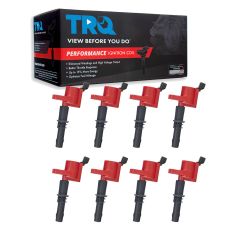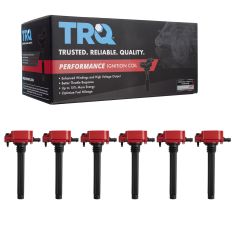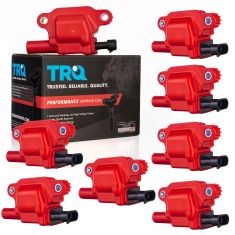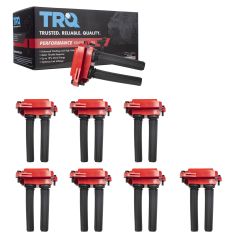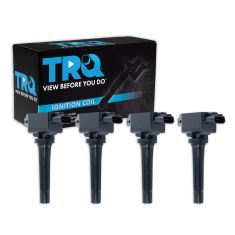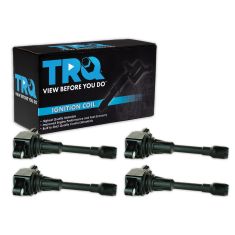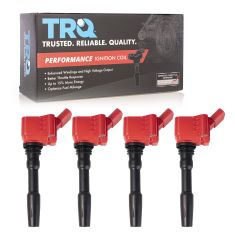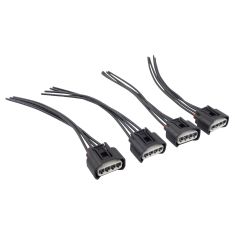Ignition Coils
-
-
- Air Deflectors & Valance Panels
- Battery Trays & Related
- Body Panels
- Bumpers & Related - Front & Rear
- Convertible Tops, Soft Tops, & Parts
- Decal & Stripe Kits
- Emblems & Nameplates
- Engine Compartment Trim
- Frame Parts & Bushings
- Fuel Door Parts
- Fuel Tank Filler Neck
- Grille
- Header Panel
- Hood & Hatch Lift Supports
- Hood Latch & Catch Brackets
- Hood Release Cable
- Jack Pads
- Radiator Supports
- Rust Repair Panels
- Splash Shields & Fender Liners
- Tailgate Cables
- Tailgate Hinges & Related
- Weatherstripping
-
- Car Covers
- Exterior Lighting
- Exterior Parts & Accessories
- Exterior Safety & Security
- Exterior Storage
- Fender Flares
- License Plate Brackets & Frames
- Mud Flaps & Splash Guards
- Nerf Bars, Side Steps, Running Boards
- Radio Antenna
- Rain Deflectors
- Roll Bars, Light Bars, & Related
- Roof Rack
- Skid Plates
- Spare Tire Carriers & Related
- Spare Tire Covers
- Tire Care
- Tonneau Covers
- Tow Hooks & D-Shackles
- Towing Accessories
- Trailer Hitch & Components
-
- Accelerator Pedal Pad
- Auto Carpet
- Brake Pedal Pad
- Clutch Pedal Pad
- Console Parts
- Dash Pad Cover
- Dash Vents
- Floor Mats & Liners
- Horns & Horn Parts
- Interior Parts & Accessories
- Mirror - Interior Rear View
- Seat Cover and Sets
- Seat Heater Kits
- Seat Parts and Accessories
- Sun Visors & Related
- Trunk & Cargo Parts
-
- Accelerator Pedals & Sensors
- Alarms, Control Modules, & Remote Start
- Cruise Control Switch & Lever
- Electrical Parts
- Hazard Switch
- Ignition Key Lock Cylinder
- Ignition Switch
- Keyless Entry Remote & Related
- Neutral Safety Switch
- Parking Assist Cameras & Monitors
- Power Mirror Switch
- Power Seat Switches
- Power Window Switch
- Radio, Navigation, Entertainment
- Reverse Light Switch
- Trunk Release & Lock Solenoids
- Turn Signal Switches and Levers
- Windshield Wiper Switch
-
- Idler Arm
- Pitman Arm
- Power Steering Hoses
- Power Steering Oil Cooler
- Power Steering Pressure Sensor
- Power Steering Pump
- Power Steering Pump Cooling Fan
- Power Steering Pump Pulley
- Power Steering Pump Reservoir
- Steering Dampers
- Steering Knuckles and Spindles
- Steering Rack and Gear Boxes
- Steering Shafts & Couplers
- Steering Wheels & Column Parts
- Tie Rods & Adjusting Sleeves
-
-
-
-
-
-
-
-
1718
172
10
10
-
Notify When Available
Replaces Nissan Infiniti Performance 6 Piece Ignition Coil Set TRQ Performance ICA61964
Brand: TRQ Performance - ICA61964$164.95Save 25%List $220.95 Save $56.00Brand: TRQ Performance - ICA61964$164.95Save 25%List $220.95 Save $56.00 -
Notify When Available
Replaces Ford Lincoln Mercury 8 Piece Performance Ignition Coil Set TRQ Performance ICA64248
Brand: TRQ Performance - ICA64248$124.95Save 13%List $143.95 Save $19.00Brand: TRQ Performance - ICA64248$124.95Save 13%List $143.95 Save $19.00 -
Notify When Available
Replaces Jeep Dodge Ram VW Chrysler 6 Piece Performance Ignition Coil Set TRQ Performance ICA71258
Brand: TRQ Performance - ICA71258$159.95Save 19%List $196.95 Save $37.00Brand: TRQ Performance - ICA71258$159.95Save 19%List $196.95 Save $37.00 -
Notify When Available
Replaces Chevrolet GMC Cadillac 8 Piece Performance Ignition Coil Set TRQ Performance ICA64246
Brand: TRQ Performance - ICA64246$199.95Save 27%List $272.95 Save $73.00Brand: TRQ Performance - ICA64246$199.95Save 27%List $272.95 Save $73.00 -
Notify When Available
Replaces Jeep Dodge Ram Chrysler 8 Piece Performance Ignition Coil Set TRQ Performance ICA64247
Brand: TRQ Performance - ICA64247$259.95Save 13%List $298.95 Save $39.00Brand: TRQ Performance - ICA64247$259.95Save 13%List $298.95 Save $39.00 -
Notify When Available$102.95Save 22%List $131.95 Save $29.00Brand: TRQ - ICA64282$102.95Save 22%List $131.95 Save $29.00
-
Notify When Available$92.95Save 19%List $114.95 Save $22.00Brand: TRQ - ICA61586$92.95Save 19%List $114.95 Save $22.00
-
Notify When Available
Replaces Chevrolet GMC Cadillac Isuzu 8 Piece Performance Ignition Coil Set TRQ Performance ICA64244
Brand: TRQ Performance - ICA64244$214.95Save 25%List $286.95 Save $72.00Replaces Chevrolet GMC Cadillac Isuzu 8 Piece Performance Ignition Coil Set TRQ Performance ICA64244
Brand: TRQ Performance - ICA64244$214.95Save 25%List $286.95 Save $72.00 -
Notify When Available
Replaces VW Audi 4 Piece Performance Ignition Coil Set TRQ Performance ICA79706
Brand: TRQ Performance - ICA79706$112.95Save 24%List $147.95 Save $35.00Brand: TRQ Performance - ICA79706$112.95Save 24%List $147.95 Save $35.00 -
Notify When Available
Replaces Ignition Coil Wire Harness 4 Piece Set DIY Solutions IGN00665
Brand: DIY Solutions - IGN00665$35.95Save 22%List $45.95 Save $10.00Brand: DIY Solutions - IGN00665$35.95Save 22%List $45.95 Save $10.00
loading...
Choose the Make of Your Vehicle

